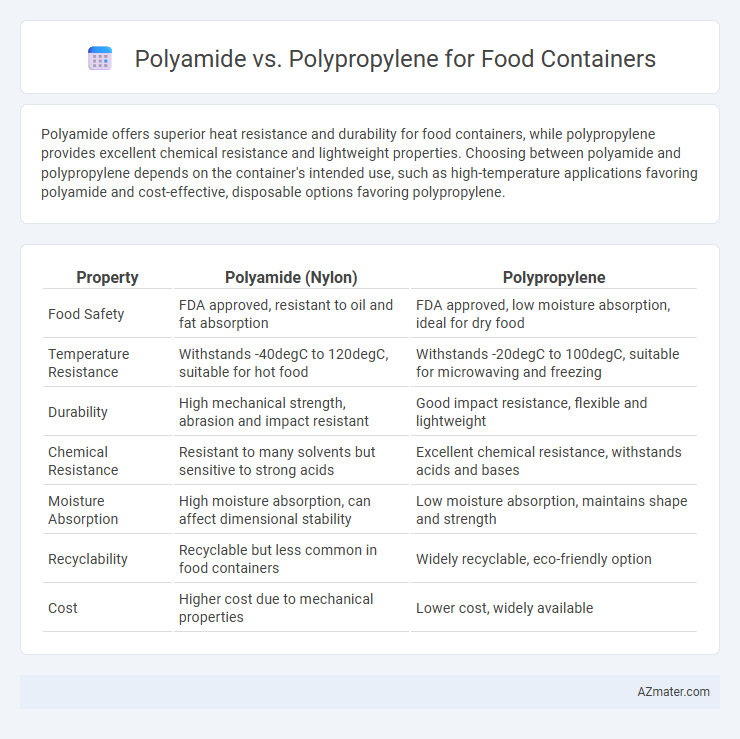Polyamide offers superior heat resistance and durability for food containers, while polypropylene provides excellent chemical resistance and lightweight properties. Choosing between polyamide and polypropylene depends on the container's intended use, such as high-temperature applications favoring polyamide and cost-effective, disposable options favoring polypropylene.
Table of Comparison
| Property | Polyamide (Nylon) | Polypropylene |
|---|---|---|
| Food Safety | FDA approved, resistant to oil and fat absorption | FDA approved, low moisture absorption, ideal for dry food |
| Temperature Resistance | Withstands -40degC to 120degC, suitable for hot food | Withstands -20degC to 100degC, suitable for microwaving and freezing |
| Durability | High mechanical strength, abrasion and impact resistant | Good impact resistance, flexible and lightweight |
| Chemical Resistance | Resistant to many solvents but sensitive to strong acids | Excellent chemical resistance, withstands acids and bases |
| Moisture Absorption | High moisture absorption, can affect dimensional stability | Low moisture absorption, maintains shape and strength |
| Recyclability | Recyclable but less common in food containers | Widely recyclable, eco-friendly option |
| Cost | Higher cost due to mechanical properties | Lower cost, widely available |
Introduction: Polyamide vs Polypropylene in Food Packaging
Polyamide and polypropylene are widely used polymers in food packaging due to their distinct properties impacting food safety and preservation. Polyamide offers excellent barrier resistance against oxygen and aroma, making it ideal for packaging products that require prolonged shelf life and freshness. In contrast, polypropylene provides superior chemical resistance and heat tolerance, ensuring durability and safe microwave use in food containers.
Chemical Structure and Properties
Polyamide (PA), known for its strong amide bonds in the polymer backbone, exhibits excellent chemical resistance, high melting points, and superior barrier properties against gases and moisture, making it suitable for durable food containers. Polypropylene (PP) features a saturated hydrocarbon chain with methyl side groups, offering a lower melting point, excellent chemical resistance to acids and bases, and high impact strength but generally lower barrier protection compared to polyamide. The inherent polar nature of polyamide enhances its resistance to oils and fats, whereas polypropylene's non-polar structure provides lightweight and flexible containers with excellent heat tolerance for microwave use.
Thermal Resistance and Temperature Tolerance
Polyamide (PA) offers superior thermal resistance with a melting point typically around 220-265degC, making it suitable for applications requiring high-temperature tolerance like hot food storage and microwave use. Polypropylene (PP) has a lower melting point, approximately 160-170degC, but exhibits good heat resistance and is often preferred for its balance of temperature tolerance and cost-effectiveness in cold and moderately hot food containers. Both materials are BPA-free and food-safe, but polyamide's higher thermal stability makes it more appropriate for repeated exposure to elevated temperatures without deformation.
Barrier Properties: Moisture, Oxygen, and Odor
Polyamide exhibits superior barrier properties against oxygen and odor compared to polypropylene, making it highly effective in preserving food freshness by preventing oxidation and flavor transfer. Polypropylene offers excellent moisture resistance but is less effective than polyamide in restricting oxygen permeability, which can impact shelf life in oxygen-sensitive foods. Choosing polyamide for food containers ensures enhanced protection from moisture and gas infiltration, critical for maintaining product integrity in packaged foods.
Mechanical Strength and Durability
Polyamide offers superior mechanical strength compared to polypropylene, making it more resistant to impact and wear in food container applications. Its toughness and high tensile strength contribute to enhanced durability under repeated use and stress, ideal for heavy-duty storage. Polypropylene, while more flexible and lightweight, lacks the rigidity and long-term durability found in polyamide, often resulting in quicker deformation and reduced lifespan when subjected to mechanical strain.
Food Safety and Regulatory Compliance
Polyamide (PA) and Polypropylene (PP) are commonly used materials in food containers, with Polypropylene often preferred for its excellent chemical resistance, low moisture absorption, and compliance with FDA and EU food safety regulations. Polyamide offers superior mechanical strength and temperature resistance but may require special coatings to meet stringent migration limits and ensure food safety compliance. Regulatory standards, such as FDA 21 CFR 177 and EU Regulation No 10/2011, provide specific guidelines for allowable substance migration, with Polypropylene typically exhibiting lower migration rates, making it a safer choice for direct food contact.
Impact on Flavor and Food Freshness
Polyamide (nylon) offers superior resistance to aroma absorption, preserving the original flavor of food stored in containers, whereas polypropylene tends to absorb and retain odors over time, potentially altering food taste. Polyamide's higher barrier properties against oxygen and moisture help maintain food freshness longer compared to polypropylene, which allows greater permeability, accelerating spoilage. Choosing polyamide containers ensures better flavor integrity and extended shelf life for sensitive food products.
Recyclability and Environmental Impact
Polyamide (PA) offers strong durability and heat resistance for food containers but poses challenges for recycling due to complex polymer structures and limited recycling streams. Polypropylene (PP) is widely recyclable with well-established collection and processing methods, resulting in lower environmental impact and higher circularity in food packaging applications. Choosing PP over PA enhances sustainability by facilitating efficient recycling and reducing plastic waste in the food container industry.
Cost-Effectiveness and Market Availability
Polypropylene offers superior cost-effectiveness compared to polyamide due to lower raw material prices and simpler manufacturing processes, making it a preferred choice for budget-conscious food container production. Polypropylene's widespread market availability ensures consistent supply and competitive pricing, whereas polyamide, though valued for higher temperature resistance, is generally more expensive and less common in food-grade containers. The dominance of polypropylene in food packaging industries highlights its balance between affordability and functional performance.
Conclusion: Which Material Is Better for Food Containers?
Polypropylene outperforms polyamide for food containers due to its superior chemical resistance, lower moisture absorption, and higher heat tolerance, making it safer for contact with various food types. Polyamide's tendency to absorb water and its vulnerability to thermal degradation limits its effectiveness in maintaining food safety and container durability. Therefore, polypropylene remains the preferred material for food containers, ensuring longer shelf life and better hygiene.

Infographic: Polyamide vs Polypropylene for Food Container
 azmater.com
azmater.com